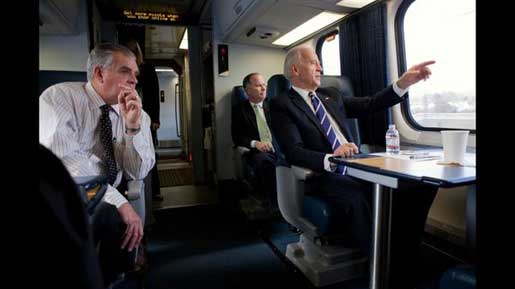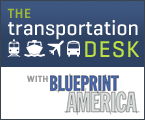Tom McNamara, Blueprint America

Vice President Joe Biden (right) riding the Amtrak rails with Transportation Secretary Ray LaHood (left) on Feb. 8, 2011. Photo: Official White House photo, David Lienemann
President Barack Obama in his State of the Union last month said he wanted to give 80 percent of Americans access to high-speed rail within 25 years. Last week, the president continued that thought, calling for a six-year, $53 billion spending plan for high-speed rail.
Vice President Joe Biden made the announcement during a visit to Philadelphia’s historic 30th Street Station, an Amtrak stop connecting Pittsburgh and the Midwest to lines running between Boston, New York City and Washington, D.C.
 “As a long time Amtrak rider and advocate,” the vice president said, “I understand the need to invest in a modern rail system that will help connect communities, reduce congestion and create quality, skilled manufacturing jobs that cannot be outsourced. This plan will help us to do that, while also increasing access to convenient high speed rail for more Americans.”
“As a long time Amtrak rider and advocate,” the vice president said, “I understand the need to invest in a modern rail system that will help connect communities, reduce congestion and create quality, skilled manufacturing jobs that cannot be outsourced. This plan will help us to do that, while also increasing access to convenient high speed rail for more Americans.”
An initial $8 billion in spending is part of the budget plan Obama released today. Then it’s up to Congress. What remains to be seen is where the remaining $45 billion for high-speed rail would come from, especially with a Republican-controlled House looking to cut and not spend.
Biden said the administration wouldn’t back down, though, when it comes to spending on the infrastructure, education and other forward-looking programs Obama championed in his address to the country last month.
“We cannot compromise,” the vice president said at the event in Philadelphia. “The rest of the world is not compromising.”
To some extent, high-speed rail opponents have made their stand. Recently elected Republican governors in Ohio and Wisconsin rejected more than a billion dollars combined in rail money. Keeping true to its word, the White House did not compromise and has since redistributed that money to states willing to build rail. But without the likes of Ohio and Wisconsin, any Midwest high-speed rail system would be nearly impossible to build. In other words, you can’t just bypass a region of the country and expect to have a nationwide network.
Already, Obama’s call to give the majority of Americans access to high-speed rail seems more ambitious than practical. In addition to the setback in the Midwest, the completion of a high-speed rail line in Florida is at least 5 years out (and that’s if the newly elected Republican governor does not reject well over $2 billion in rail dollars from the feds, which remains a possibility); and the first line of the California statewide network is a decade out at best. After that, any high-speed rail money that has been distributed so far has mainly been spread around the country with minimal investments in conventional train service, like Amtrak.
Representative John Mica, Republican of Florida and chairman of the House Transportation and Infrastructure Committee, had “extreme reservations” about the Obama plan. “This is like giving Bernie Madoff another chance at handling your investment portfolio,” he said in a statement.
That’s not to say Mica does not support high-speed rail. Simply, he wants to direct the initial investment to the corridor that links Washington, Philadelphia, New York and Boston with trains that already reach up to 110 mph (the minimum threshold to be considered as high-speed). “Rather than focusing on the Northeast Corridor, the most congested corridor in the nation and the only corridor owned by the federal government, the administration continues to squander limited taxpayer dollars on marginal projects,” he said.


